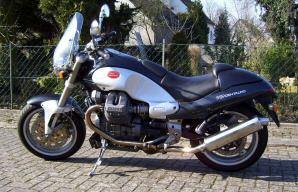
Buenas Plot..., me alegra que poco a poco vayas pillando el "intringulis" técnico..., es muy conveniente si se tiene una Guzzi ...
Bueno, en las "directrices básicas" que te pasaron, recomiendan ENCARECIDAMENTE (MUST !!!! ) que conectes la carcasa del regulador al borne negativo de la batería, usa para ello un cable con un grosor mínimo de 4mm .
Dicen que la ausencia de este cable, genera picos de voltaje que llevarian a la destrucción de la ECU (caja negra)...
Ya sabes, manos a la obra... Es facil de hacer y te ahorrarás sustos...
matt
Efectivamente Plot...., se trata del reglaje de válvulas... Recomiendan regular la válvula de admisión a 0,15mm , y la de escape a 0,20mm.
Esto significa dejarla a 0,05mm más de lo descrito en el manual de usuario, pero según dicen, es necesario para garantizar una "estabilidad" a largo tiempo, y mantener los intervalos de mantenimiento cada 10000 kilómetros. Sin ello , incluso a ralentí iría mal...
Estos temas los puedes ir "recopilando" y cuando la lleves al taller le comunicas al paisano que te la deje como tu quieres...
matt
Si sale aceite del frente de la caja del cardan, se debe cambiar el retén del eje... , caben dos retenes !!!
No sé exactamente a que retén se refiere..., lo mejor es que preguntes cual exactamente , mira el siguiente esquema:
Si el aceite sale de cualquier otro sitio, taladra un pequeño orificio en el tornillo de llenado, conectale un tubito de plástico y posiciona el otro extremo del tubo lo mas alto posible. Yo tengo ese tubo en dirección a la caja de cambio , debajo del asiento, finalizando cerca de la ECU
Con ese tubito lo que se pretende es crear un "respiradero" para la sobre presión de aceite que pueda haber... , normalmente acaba en algún "recoge-aceites made en casa", como puede ser una lata de coca cola (te sirve tambien cualquier otro refresco ) Lo vas controlando y cuando esté lleno lo vacias...
Aunque el tema de la sobrepresión no es tan facil como ponerle el respiradero... Lo primero es procurar no llenar demasiado aceite, lo mejor es tener la cantiad justa... , que se mantenga entre mínimo y máximo...
Si echa mucho aceite (incluso teniendo el justo) puede ser indicativo de cilindros gastados ... , éstos al tener mucha holgura, ejercen presión hacia el carter
La horquilla delantera debe rebajarse en 10mm
Se refiere a rebajar la altura de las barras delanteras.... Seguro que así se consigue una mejor conducción. La manera de hacerlo es dejar que las barras "sobresalgan" de la tija 10 milimetros. En la siguiente foto podrás observar como las barras (en color bronce ) sobresalen de la tija..., de esta manera bajas la suspensión delantera:
Cita
No uses jamás pastillas de freno sinterizadas
Seguro que lo dice porque al ser mas duras que las normales, se "comen" el disco de freno muy rápido...
matt
Tema 4
Pinzas de freno:
Cambia los tornillos estandar de 8.8 que aprietan la mitad de cada pinza frontal de frenos , por unos M8x40mm de tipo "allen" . El par de apriete debe ser de 40 Nm.
Obtendrás una frenada lineal en vez de decreciente
Se refiere a los dos tornillos que van en la parte frontal de cada pinza (freno delantero).... En la imagen (pinza izquierda ) verás los huecos donde van...
matt
Presión de gasolina: Conecta el medidor de presión de gasolina a una de las tomas o a las dos... Incrementará la manejabilidad en cambios de lastre (ver mi descripción de EPROMs ) .
Correa de distribución: Contitech Syncroforce CXP STD 640-S8M-20 con 80 dientes.
TEMA 6:
Nivel de aceite de motor: 10 mm por encima del máximo (con el medidor totalmente enroscado )
Aceite de motor: Sintético 10W60, 1oW50 o 20W60. Nunca 5W... or 0W...
Nivel de aceite de la caja de cambios: Sintético 0,60l. Olvídate del indicador de nivel.
Nivel de aceite del cardan: Sintético 0,20l. Olvídatte del indicador de nivel
Filtro de gasolina: Mahle KL14, Art. 07637655 o MANN WK 613
Filtro de aceite: MANN W712/52
No estoy muy de acuerdo con el nivel de aceite del motor, yo jamás sobrepasaría el nivel de máximo... , lo mejor es dejarlo un pelín por encima de la mitad y controlarlo a menudo...
Sobre los filtros de aceite, tambien :
> Bloque 1100 (Centauro, Cali, V11, etc... )
UFI 2328700
CHAMPION C305
HIFLO-FILTRO HF551 (incluso Griso, Stone, Quota... )
Purolator ML17782
Rojo = Alternativos contrastados en la web del fabricante.

